Click here to subscribe today or Login.
PITTSTON — Northeastern Pennsylvania is comprised of seven counties with a total population of 1,028,926. The region’s urban center is the Scranton/Wilkes-Barre/Hazleton Metropolitan Statistical Area, with a population of 558,166.
Our region is increasingly diverse: Northeastern Pennsylvania’s minority population has grown from 5.9 percent of the total in 2000 to almost 15 percent today.
Many of our residents are descended from immigrants who came here to build better lives for themselves and their families. Now, our newest residents are moving here because Northeastern Pennsylvania offers them the same opportunities today.
We’re confident that, with the right employment mix, Northeastern Pennsylvania has the ability to attract and retain strong technical talent.
We’ve already built the human capital pipeline — today, more than 40,000 graduate and undergraduate students are enrolled at our 19 area colleges and universities.
Our seven counties have a total labor force of 494,900, with 3.2 percent of all jobs within the region (11,239 people) employed in the professional, scientific, and technical services sector, and another 6,388 people (1.8 percent of total) working in the information sector.
From 2013 to 2015, 315 new tech jobs were added within the Scranton/Wilkes-Barre/Hazleton metro area, representing a compound average growth rate of 9.4 percent from 2013 to 2015.
In order to enhance the technical skills of our region’s existing workforce Northeastern Pennsylvania has established several workforce development programs.
One example is “Skills in Scranton,” the Greater Scranton Chamber’s Business Education Partnership, which uses industry-specific committees, educator in the workplace forums; an annual high school principals’ forum; employer-driven curriculum counsel; and coordination of regular student visits to work-sites and industry expert lectures in classrooms to facilitate career awareness, internships, and apprenticeships for hundreds of area students and dozens of employers.
We off affordability
Your dollar goes much further in Northeastern Pennsylvania. We offer a dramatically lower cost of living compared to similarly large and mid-sized cities in other parts of the country.
In 2015, the Economic Policy Institute reported that the cost of living in the Scranton/Wilkes-Barre/Hazleton metro area was approximately 95 percent of the U.S. average.
Housing prices comprise a large portion of those cost savings; in August 2017, Zillow reported that the MSA’s median home value was $118,500, compared to $201,900 in the United States as a whole. Zillow’s research states that home prices in the MSA appreciated by 5 percent during the last year, compared to 6.9 percent in the US as a whole.
We offer access
Northeastern Pennsylvania is only a two-hour drive from both New York City and Philadelphia. We’re within 600 miles of 50 percent of the nation’s population and 80 percent of the U.S. population can be reached within two days or less. We are the Northeast’s interstate hub — the place where Interstates 80, 81, 84, and 476 meet, accessing 80 million consumers within an overnight drive.
• 55 percent of the approximately 351,000 workers within Northeastern Pennsylvania’s seven counties travel fewer than 10 miles to work each day.
• Another 22 percent commute between 10 and 24 miles.
• The remaining 23 percent commute greater than 25 miles on a daily basis. In fact, the average NEPA resident spends only 21 minutes commuting to work.
Additionally, our region’s highway network provides easy access to the substantial employment pools in the adjoining New York/New Jersey, Greater Philadelphia, Lehigh Valley, and Binghamton metro areas.
Northeastern Pennsylvania’s Wilkes-Barre/Scranton International Airport (located midway between Wilkes-Barre and Scranton) is served by American, Delta, and United Airlines, with daily direct flights to Atlanta, Charlotte, Chicago, Detroit, Newark, and Philadelphia.
And the region has easy access to Philadelphia International Airport and Newark International Airport — both airports are less than two hours away, and both offer daily direct flights to San Francisco, New York, Seattle, and Washington, DC.
We offer productivity
Northeastern Pennsylvania possesses real economic strength — the Scranton/Wilkes-Barre/Hazleton metropolitan area alone represents $23,068,000,000 in annual economic output.
However, we also have plenty of room to grow — the three urbanized counties along the region’s Interstate 81 corridor are home to 300,000 fewer residents than at their peak.
Put another way, our region’s urban centers currently possess the infrastructure to accommodate a population twice the number that’s here today.
We offer resiliency/sustainability
Northeastern Pennsylvania is a resilient and sustainable region. We’re a place with a very low risk of disruption from natural disaster — whether it’s earthquakes, tornadoes, hurricanes, droughts, or rising oceans. We possess an abundance of fresh water, a surplus of available land, and a robust transportation and telecommunication infrastructure with the capacity to support growth.
We offer a unique combination — we adjoin the Northeast megalopolis, but we’re just far enough away not to be subject to our neighbors’ threat profile, overcrowded highways, and extreme housing prices.
We offer superb quality of
life in a high-quality place
Northeastern Pennsylvania offers a wealth of walkable neighborhoods, beautiful historic buildings, cultural institutions, parks, and sporting opportunities that enrich the lives of our region’s residents.
Our remarkably low cost of living is combined with an amazing quality of life: beautiful lakes, rivers, and forests; Pocono trails and ski slopes; dozens of golf courses; and everything from kayaking to rock climbing to the Northeastern United States’ best fly fishing is right here – making us the Mid-Atlantic’s mountain playground.
The region boasts a wonderful array of protected natural assets: 54,536 acres of State Parks and 85,239 acres of State Forest land, 4,700 miles of rivers and streams, and 75 square miles of lakes and ponds.
Our lakes, ski areas, and resorts draw thousands of visitors seeking less-rustic vacations. Others choose wilderness-oriented pursuits, such as hunting, fishing, hiking, biking, rafting, snowmobiling, cross-country skiing, and other low-impact recreational activities. Just in the four Pocono Mountain counties alone, visitation translates to more than 9.1 million overnight trips and 15.9 million day trips annually.
For fans of spectator sports, NEPA offers NASCAR racing at the Pocono International Raceway; professional minor-league baseball (the Scranton/Wilkes-Barre Rail Riders, the Triple-A affiliate of the New York Yankees, plays at PNC Field in Moosic); and professional minor-league hockey (home ice for the Wilkes-Barre Scranton Penguins, the AHL affiliate of the Pittsburgh Penguins, is the Mohegan Sun Arena in Wilkes-Barre).
NEPA communities such as Jim Thorpe and Stroudsburg helped to pioneer Pennsylvania’s Main Street revitalization efforts, reviving once-dormant downtowns with new economic activity. Today, downtown revitalization is transforming the region’s largest cities, as Carbondale, Hazleton, Pittston, Pottsville, Scranton, and Wilkes-Barre are working to create downtowns that are points of pride for their communities, with new activity centers and amenities that attract workers, residents, and visitors.
The results have been startling. For example, during the past five years, the number of young college graduates residing in Downtown Wilkes-Barre has doubled, while 32 percent of wage-earning Downtown residents now walk to work — compared to 3 percent in Luzerne County as a whole.
The relationship between healthy, walkable mixed-use neighborhoods and the growth of the knowledge economy has been embraced in Wilkes-Barre’s center city — it holds more than two-dozen different tech start-ups, and it’s home to one-third of all the information-sector jobs in the metro area.
We offer a chance
to reinvent a region
We believe that growing existing companies and locating new quality employers can serve as a catalyst for the next phase of Northeastern Pennsylvania’s economic reinvention.
As a purely economic proposition, our region’s human capital, its wealth of educational institutions, its unparalleled location, and its existing infrastructure represent enormous latent value. We’ve already begun the job of unlocking that value.
Let Penn’s Northeast be your easy button for economic development in Northeastern PA. Visit www.pennsnortheast.com to see how we can help your company.
To read more of our Industrial Park Series, click here.







